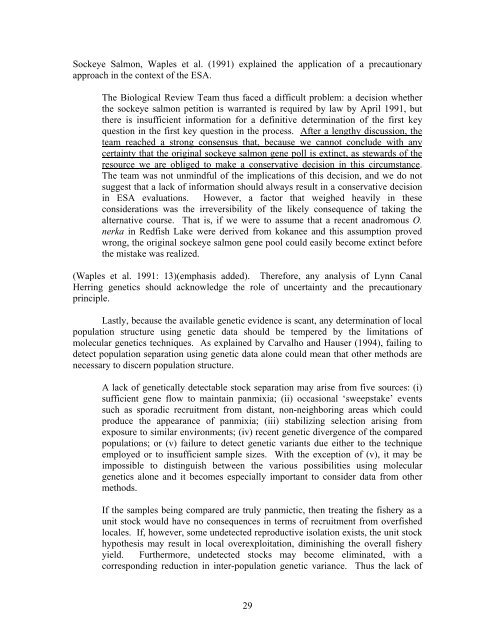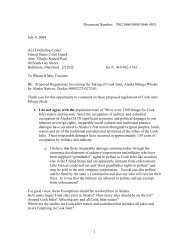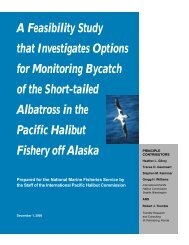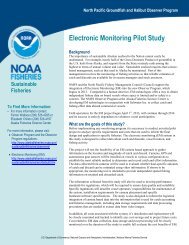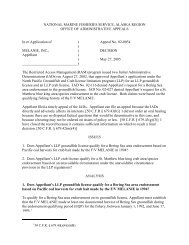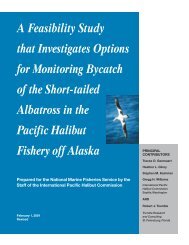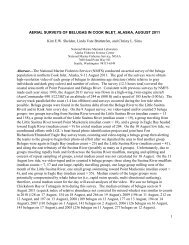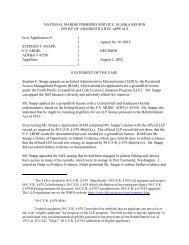Petition to List Lynn Canal Pacific Herring under the Endangered ...
Petition to List Lynn Canal Pacific Herring under the Endangered ...
Petition to List Lynn Canal Pacific Herring under the Endangered ...
You also want an ePaper? Increase the reach of your titles
YUMPU automatically turns print PDFs into web optimized ePapers that Google loves.
Sockeye Salmon, Waples et al. (1991) explained <strong>the</strong> application of a precautionary<br />
approach in <strong>the</strong> context of <strong>the</strong> ESA.<br />
The Biological Review Team thus faced a difficult problem: a decision whe<strong>the</strong>r<br />
<strong>the</strong> sockeye salmon petition is warranted is required by law by April 1991, but<br />
<strong>the</strong>re is insufficient information for a definitive determination of <strong>the</strong> first key<br />
question in <strong>the</strong> first key question in <strong>the</strong> process. After a lengthy discussion, <strong>the</strong><br />
team reached a strong consensus that, because we cannot conclude with any<br />
certainty that <strong>the</strong> original sockeye salmon gene poll is extinct, as stewards of <strong>the</strong><br />
resource we are obliged <strong>to</strong> make a conservative decision in this circumstance.<br />
The team was not unmindful of <strong>the</strong> implications of this decision, and we do not<br />
suggest that a lack of information should always result in a conservative decision<br />
in ESA evaluations. However, a fac<strong>to</strong>r that weighed heavily in <strong>the</strong>se<br />
considerations was <strong>the</strong> irreversibility of <strong>the</strong> likely consequence of taking <strong>the</strong><br />
alternative course. That is, if we were <strong>to</strong> assume that a recent anadromous O.<br />
nerka in Redfish Lake were derived from kokanee and this assumption proved<br />
wrong, <strong>the</strong> original sockeye salmon gene pool could easily become extinct before<br />
<strong>the</strong> mistake was realized.<br />
(Waples et al. 1991: 13)(emphasis added). Therefore, any analysis of <strong>Lynn</strong> <strong>Canal</strong><br />
<strong>Herring</strong> genetics should acknowledge <strong>the</strong> role of uncertainty and <strong>the</strong> precautionary<br />
principle.<br />
Lastly, because <strong>the</strong> available genetic evidence is scant, any determination of local<br />
population structure using genetic data should be tempered by <strong>the</strong> limitations of<br />
molecular genetics techniques. As explained by Carvalho and Hauser (1994), failing <strong>to</strong><br />
detect population separation using genetic data alone could mean that o<strong>the</strong>r methods are<br />
necessary <strong>to</strong> discern population structure.<br />
A lack of genetically detectable s<strong>to</strong>ck separation may arise from five sources: (i)<br />
sufficient gene flow <strong>to</strong> maintain panmixia; (ii) occasional ‘sweepstake’ events<br />
such as sporadic recruitment from distant, non-neighboring areas which could<br />
produce <strong>the</strong> appearance of panmixia; (iii) stabilizing selection arising from<br />
exposure <strong>to</strong> similar environments; (iv) recent genetic divergence of <strong>the</strong> compared<br />
populations; or (v) failure <strong>to</strong> detect genetic variants due ei<strong>the</strong>r <strong>to</strong> <strong>the</strong> technique<br />
employed or <strong>to</strong> insufficient sample sizes. With <strong>the</strong> exception of (v), it may be<br />
impossible <strong>to</strong> distinguish between <strong>the</strong> various possibilities using molecular<br />
genetics alone and it becomes especially important <strong>to</strong> consider data from o<strong>the</strong>r<br />
methods.<br />
If <strong>the</strong> samples being compared are truly panmictic, <strong>the</strong>n treating <strong>the</strong> fishery as a<br />
unit s<strong>to</strong>ck would have no consequences in terms of recruitment from overfished<br />
locales. If, however, some undetected reproductive isolation exists, <strong>the</strong> unit s<strong>to</strong>ck<br />
hypo<strong>the</strong>sis may result in local overexploitation, diminishing <strong>the</strong> overall fishery<br />
yield. Fur<strong>the</strong>rmore, undetected s<strong>to</strong>cks may become eliminated, with a<br />
corresponding reduction in inter-population genetic variance. Thus <strong>the</strong> lack of<br />
29


